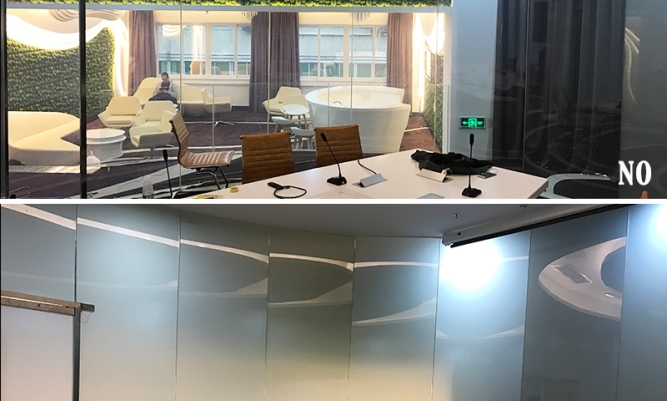

Electronic atomized glass, also known as intelligent dimming glass or photoelectric glass, is a modern building material with multiple functions. The following is a summary of the manufacturing process and related information of electronic atomized glass:
Manufacturing process:
The manufacturing of electronic atomized glass usually adopts the dry laminated glass production process, which is formed by firmly bonding a dimming film between two ordinary float glass sheets.
The liquid crystal molecules (PDLC) in the dimming film scatter and present a frosted state when not powered; When powered on, the liquid crystal molecules align into lines, and the glass becomes transparent.
The manufacturing process includes the preparation of glass raw materials, dimming gel materials, thermal conductive materials, process preparation, glass body firing, tempering and forming, composite glass structure forming, and thermal stability forming.
characteristic:
Electronic atomized glass has the characteristics of being transparent when powered on and opaque when powered off, while also possessing various properties of laminated glass.
The selection of film, electronic color changing film, temperature treatment of film, and the lifespan of film under ultraviolet irradiation are all key factors affecting the performance of electronic atomized glass.
Application:
Electronic atomized glass is widely used in building decoration, such as doors, windows, sunrooms, etc. It can be controlled to turn on and off the glass through a mobile app, achieving free adjustment of light.
In the automotive field, electronic atomized glass can be used to manufacture windshield structures with certain insulation, phase display function, good heat dissipation, good transparency, adjustable transparency, and long service life.
Safety and Environmental Protection:
When electronic atomized glass is shattered by impact, glass fragments stick to the middle film to prevent them from splashing and injuring people.
Dimming film and film can shield over 90% of infrared radiation and over 99% of ultraviolet radiation, reduce heat transfer, protect indoor furnishings from fading, and prevent diseases caused by direct ultraviolet radiation.
Soundproofing:
The dimming film and film in the middle of electronic atomization glass have sound damping effect, which can effectively block noise.
Market and Trends:
With the development and innovation of technology, the transparency of electronic atomized glass has been improved, and it is divided into four types: ordinary white ordinary transparency, ordinary white high transparency, ultra white ordinary transparency, and ultra white high transparency.
The demand for electronic atomized glass in the market is constantly increasing, especially in high-end residential areas, villas and other places, as an ideal sunshade material.



